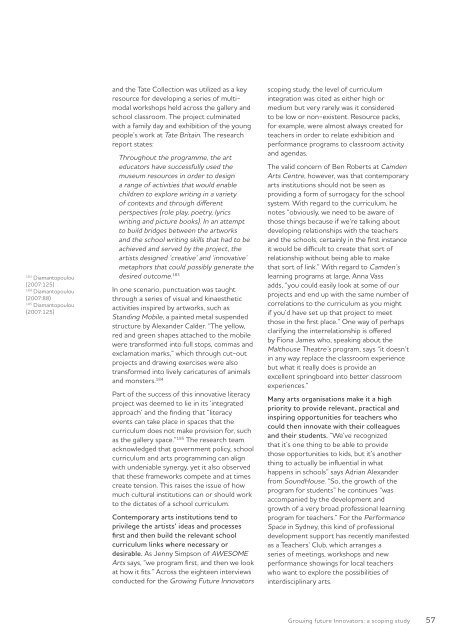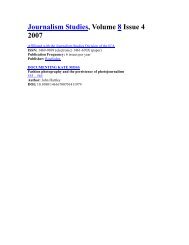GrowinG Future innovators - ARC Centre of Excellence for Creative ...
GrowinG Future innovators - ARC Centre of Excellence for Creative ...
GrowinG Future innovators - ARC Centre of Excellence for Creative ...
Create successful ePaper yourself
Turn your PDF publications into a flip-book with our unique Google optimized e-Paper software.
183 Diamantopoulou<br />
(2007:125)<br />
184 Diamantopoulou<br />
(2007:88)<br />
185 Diamantopoulou<br />
(2007:125)<br />
and the Tate Collection was utilized as a key<br />
resource <strong>for</strong> developing a series <strong>of</strong> multimodal<br />
workshops held across the gallery and<br />
school classroom. The project culminated<br />
with a family day and exhibition <strong>of</strong> the young<br />
people’s work at Tate Britain. The research<br />
report states:<br />
Throughout the programme, the art<br />
educators have successfully used the<br />
museum resources in order to design<br />
a range <strong>of</strong> activities that would enable<br />
children to explore writing in a variety<br />
<strong>of</strong> contexts and through different<br />
perspectives (role play, poetry, lyrics<br />
writing and picture books). In an attempt<br />
to build bridges between the artworks<br />
and the school writing skills that had to be<br />
achieved and served by the project, the<br />
artists designed ‘creative’ and ‘innovative’<br />
metaphors that could possibly generate the<br />
desired outcome. 183<br />
In one scenario, punctuation was taught<br />
through a series <strong>of</strong> visual and kinaesthetic<br />
activities inspired by artworks, such as<br />
Standing Mobile, a painted metal suspended<br />
structure by Alexander Calder. “The yellow,<br />
red and green shapes attached to the mobile<br />
were trans<strong>for</strong>med into full stops, commas and<br />
exclamation marks,” which through cut-out<br />
projects and drawing exercises were also<br />
trans<strong>for</strong>med into lively caricatures <strong>of</strong> animals<br />
and monsters. 184<br />
Part <strong>of</strong> the success <strong>of</strong> this innovative literacy<br />
project was deemed to lie in its ‘integrated<br />
approach’ and the finding that “literacy<br />
events can take place in spaces that the<br />
curriculum does not make provision <strong>for</strong>, such<br />
as the gallery space.” 185 The research team<br />
acknowledged that government policy, school<br />
curriculum and arts programming can align<br />
with undeniable synergy, yet it also observed<br />
that these frameworks compete and at times<br />
create tension. This raises the issue <strong>of</strong> how<br />
much cultural institutions can or should work<br />
to the dictates <strong>of</strong> a school curriculum.<br />
Contemporary arts institutions tend to<br />
privilege the artists’ ideas and processes<br />
first and then build the relevant school<br />
curriculum links where necessary or<br />
desirable. As Jenny Simpson <strong>of</strong> AWESOME<br />
Arts says, “we program first, and then we look<br />
at how it fits.” Across the eighteen interviews<br />
conducted <strong>for</strong> the Growing <strong>Future</strong> Innovators<br />
scoping study, the level <strong>of</strong> curriculum<br />
integration was cited as either high or<br />
medium but very rarely was it considered<br />
to be low or non-existent. Resource packs,<br />
<strong>for</strong> example, were almost always created <strong>for</strong><br />
teachers in order to relate exhibition and<br />
per<strong>for</strong>mance programs to classroom activity<br />
and agendas.<br />
The valid concern <strong>of</strong> Ben Roberts at Camden<br />
Arts <strong>Centre</strong>, however, was that contemporary<br />
arts institutions should not be seen as<br />
providing a <strong>for</strong>m <strong>of</strong> surrogacy <strong>for</strong> the school<br />
system. With regard to the curriculum, he<br />
notes “obviously, we need to be aware <strong>of</strong><br />
those things because if we’re talking about<br />
developing relationships with the teachers<br />
and the schools, certainly in the first instance<br />
it would be difficult to create that sort <strong>of</strong><br />
relationship without being able to make<br />
that sort <strong>of</strong> link.” With regard to Camden’s<br />
learning programs at large, Anna Vass<br />
adds, “you could easily look at some <strong>of</strong> our<br />
projects and end up with the same number <strong>of</strong><br />
correlations to the curriculum as you might<br />
if you’d have set up that project to meet<br />
those in the first place.” One way <strong>of</strong> perhaps<br />
clarifying the interrelationship is <strong>of</strong>fered<br />
by Fiona James who, speaking about the<br />
Malthouse Theatre’s program, says “it doesn’t<br />
in any way replace the classroom experience<br />
but what it really does is provide an<br />
excellent springboard into better classroom<br />
experiences.”<br />
Many arts organisations make it a high<br />
priority to provide relevant, practical and<br />
inspiring opportunities <strong>for</strong> teachers who<br />
could then innovate with their colleagues<br />
and their students. “We’ve recognized<br />
that it’s one thing to be able to provide<br />
those opportunities to kids, but it’s another<br />
thing to actually be influential in what<br />
happens in schools” says Adrian Alexander<br />
from SoundHouse. “So, the growth <strong>of</strong> the<br />
program <strong>for</strong> students” he continues “was<br />
accompanied by the development and<br />
growth <strong>of</strong> a very broad pr<strong>of</strong>essional learning<br />
program <strong>for</strong> teachers.” For the Per<strong>for</strong>mance<br />
Space in Sydney, this kind <strong>of</strong> pr<strong>of</strong>essional<br />
development support has recently manifested<br />
as a Teachers’ Club, which arranges a<br />
series <strong>of</strong> meetings, workshops and new<br />
per<strong>for</strong>mance showings <strong>for</strong> local teachers<br />
who want to explore the possibilities <strong>of</strong><br />
interdisciplinary arts.<br />
Growing future Innovators: a scoping study 57




![Plebiscite (Riegert chapter) revised FINAL [Feb 14].pdf](https://img.yumpu.com/8710373/1/190x245/plebiscite-riegert-chapter-revised-final-feb-14pdf.jpg?quality=85)